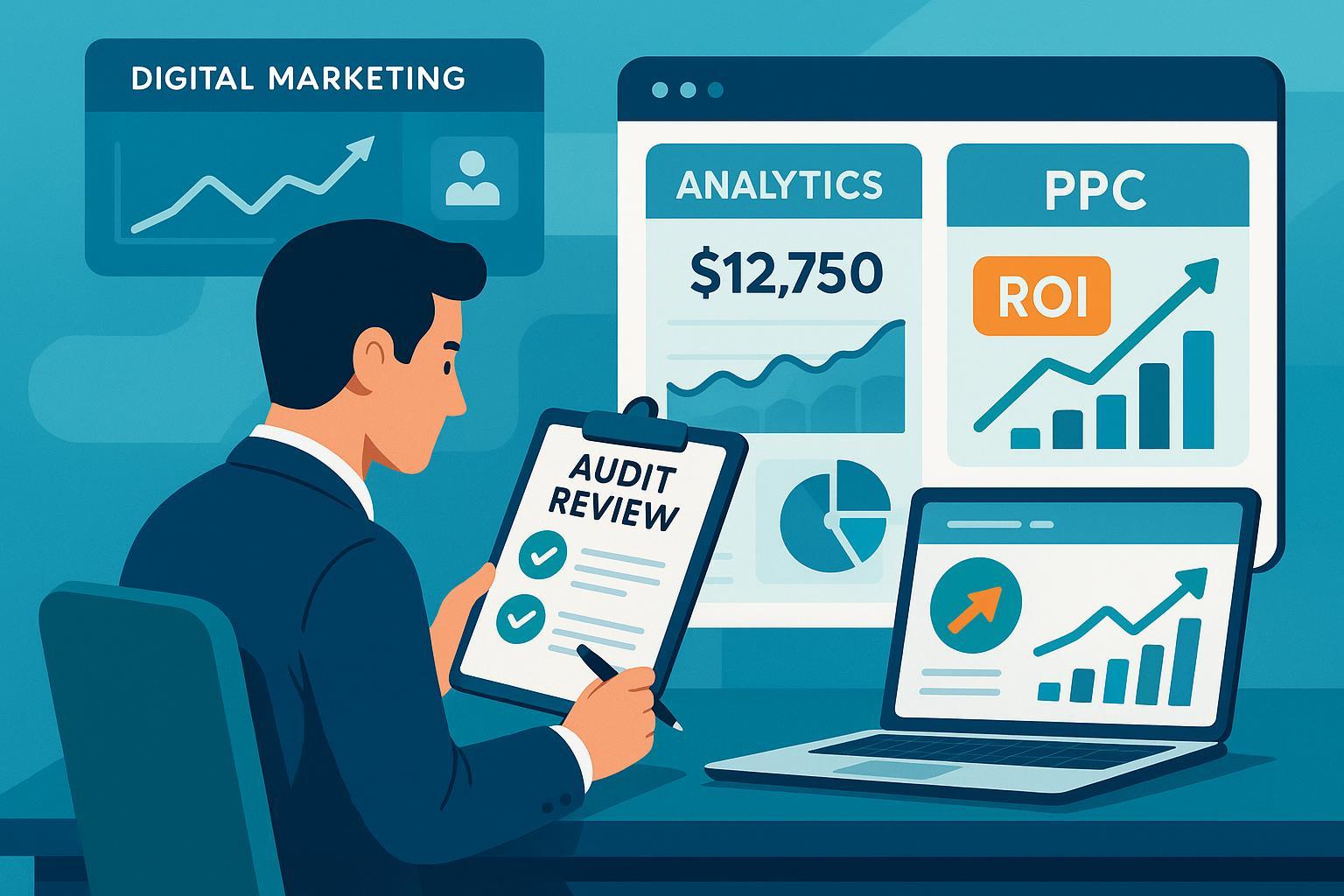The Importance of Regular Pay Per Click Audits for Maximizing ROI

Introduction
Still struggling with wasted ad spend and unsatisfying returns on your PPC campaigns? You’re not alone. It’s estimated that 15–25% of PPC budgets are wasted each year due to unmanaged keywords, outdated bidding strategies, and suboptimal tracking (WordStream, 2019). For digital marketing professionals, this is more than a benign oversight—it’s a missed opportunity for significant, measurable ROI gains. The cornerstone to sustainable PPC success? Regular, structured audits.
This guide breaks down proven, expert-backed best practices for implementing PPC audits that actually move the needle. You’ll learn an actionable audit checklist, advanced strategies for experienced marketers, and see the data-backed impact of routine reviews so you can finally maximize your paid media ROI.
7 Essential Best Practices for PPC Audits That Deliver ROI
- Establish a Multi-Tiered Audit Cadence
- Assess Campaign Structure and Targeting Relevance
- Ruthlessly Audit and Optimize Negative Keywords
- Analyze Ad Copy, Creative Fatigue, and Landing Page Alignment
- Scrutinize Bid Strategies, Budget Allocation, and Automation
- Validate Conversion Tracking and Attribution Integrity
- Leverage Advanced Tools and Reporting Dashboards
1. Establish a Multi-Tiered Audit Cadence
What/Why: PPC is not “set and forget”—ad platforms and user behavior shift rapidly. Auditing at multiple intervals (weekly, monthly, quarterly) ensures problems are caught before they drain performance.
How:
- Daily/Weekly: Spot sudden spend anomalies, policy issues, and metric drops.
- Monthly: Review creative assets, adjust audiences, update negative keywords.
- Quarterly: Conduct a deep-dive on account structure, attribution, compliance, and strategic alignment.
- Annually: Evaluate entire account portfolio and update for industry changes (e.g., privacy regulations).
Impact: Agencies applying this cadence have seen 4.5x ROI gains compared to less frequent auditing (HawkSEM Case Study).
2. Assess Campaign Structure and Targeting Relevance
What/Why: Poor structural hygiene—like disorganized ad groups or irrelevant geotargeting—creates budget waste and dilutes results.
How:
- Audit campaign/account hierarchy: ensure tight thematic groupings, match types, and intent grouping.
- Verify geotargeting is precise and exclusion lists are used where appropriate.
- Review ongoing audience segments for redundancy or decay.
Effect: Cleaner structure can boost CTR 5–20% and reduce CPA, as widely observed across agency portfolios (Swydo Guide).
3. Ruthlessly Audit and Optimize Negative Keywords
What/Why: Unchecked, irrelevant search queries silently drain budgets. Negative keyword pruning is a proven lever for eliminating waste.
How:
- Review search terms weekly/monthly and add negatives for non-converting or low-value intents.
- Use tools like Adalysis or Optmyzr to identify negative keyword conflicts and gaps.
- Segment by device and time to uncover hidden spend drains.
Effect: Mid-to-high-spend campaigns have reclaimed 10–30% of wasted budget after regular negative keyword intervention (Improvado Analysis).
4. Analyze Ad Copy, Creative Fatigue, and Landing Page Alignment
What/Why: Underperforming ads or misaligned landing pages kill conversions. Creative fatigue quickly sets in, especially with Performance Max and dynamic campaigns.
How:
- Rotate and A/B test ad copy regularly.
- Replace creative assets showing fatigue (identified through falling CTR or engagement in asset-level reports).
- Ensure every ad sends users to the most relevant landing page for their intent.
Effect: Structured creative reviews can directly increase conversion rates, with some audits leading to +18% improvement in ROAS for e-commerce accounts (anonymized agency data).
5. Scrutinize Bid Strategies, Budget Allocation, and Automation
What/Why: Automated bidding and budget rules are only as smart as their ongoing oversight. Sudden shifts in algorithm or market conditions can skew spend and harm return.
How:
- Check bid modifiers by device, audience, and time-of-day. Flag anomalies.
- Regularly validate that budget caps align with performance intent.
- Monitor for automation-induced mistakes (e.g., overly aggressive Smart Bidding pushes, poor learning-phase results).
Effect: Routine optimization keeps CPA and ROAS on track and prevents "creep." Automation audits enable early detection of budget leaks or learning failures.
6. Validate Conversion Tracking and Attribution Integrity
What/Why: Inaccurate or broken conversion tracking leads to fundamentally flawed reporting and suboptimal bidding.
How:
- Use Google Tag Assistant and other validation tools monthly for tracking accuracy.
- Review attribution models, especially after account or campaign restructuring.
- Upgrade to server-side tagging and privacy-compliant solutions (e.g., Google Consent Mode) where possible.
Effect: Fixing conversion tracking has, in practice, accounted for 15–40% improvements in measured ROAS after previously undetected issues were found (Coupler.io Audit Guide).
7. Leverage Advanced Tools and Reporting Dashboards
What/Why: Manual audits are time-consuming and prone to oversight. Professional tools automate diagnostics, flag hidden issues, and visualize trends for data-driven decisions.
How:
- Use audit platforms such as:
- Adalysis: Automated issue detection and negative keyword management.
- Optmyzr: Advanced cross-platform audit and workflow automation (Optmyzr Tool Review).
- TrueClicks: Policy compliance and actionable scoring across accounts.
- Opteo: Continuous monitoring and instant alerting for large-scale accounts.
- Consider integrating dashboards and downloadable checklists for self-audit—see resources at Coupler.io.
Effect: Leading agencies credit these tools with measurable reductions in audit time, faster waste elimination, and improved ROI clarity for stakeholders.
Real-World Impact: Mini-Case & Benchmark Data
- Tri State Gate: After a full PPC overhaul and regular quarterly audits, the company reported a significant spike in lead volume and a sustained drop in wasted spend (source: Adventure PPC; case summary).
- Industry aggregate: Structured, multi-level audits typically return 5–20% CTR gain and ROAS increases of 15–40% due to improved targeting, conversion, and attribution hygiene.
Conclusion & Next Steps
Regular, expert-led PPC audits deliver more than marginal gains—they’re a professional necessity for maximizing your advertising ROI and preventing costly campaign drift. By adopting a disciplined audit cadence and layering in advanced tools, negative keyword management, and robust reporting frameworks, you’ll put your spend to its most efficient use.
Action: Schedule your next multi-tiered audit now—use the frameworks and tool suggestions above, and remember: consistent review is the fastest route to superior PPC performance.
For advanced templates and dashboards, see the downloadable resources at Coupler.io.
Further Reading:
Remember: ROI wins aren’t accidental. They’re audited, measured, and improved—regularly.

